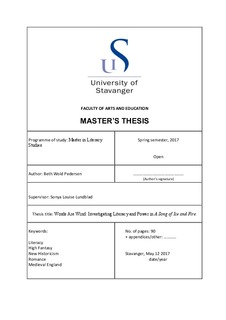| dc.description.abstract | The proposed thesis seeks to investigate how some of the characters of the book series A Song of Ice and Fire by George R.R.Martin are limited by different social structures of masculinity, physical prowess, feudal power and chivalric principles. Furthermore, the thesis seeks to investigate how literacy is depicted in A Song of Ice and Fire, and to understand if Tyrion Lannister, Samwell Tarly, Ser Davos Seaworth, Cersei Lannister, Sansa Stark and Arya Stark are able to use literacy to balance the social discourses of power. Through analysis of all five novels in the series; A Game of Thrones (1996), A Clash of Kings (1999), A Storm of Swords (2000), A Feast for Crows (2005), and A Dance with Dragons (2011) the thesis will discuss both the characters literacy narratives and the medieval-like setting of Martin’s world. Several of the characters of ASOIAF reads books, and to a certain point, knowledge will aid and sustain them. Martin has created a medieval-like world for his book series, and the thesis tries to reveal the similarities between medieval England and his fictional realm. Elements that are recognizable from this period is the feudal system, the kings, the noble families, and the knights. In addition, the thesis investigates any links between romance elements and A Song of Ice and Fire, like the trope of the knight, the damsel in distress and the trope of the wilderness. ASOIAF is defined as high fantasy, but the thesis questions this definition, and proposes a new definition, a merge between high fantasy and new historicist fiction. There are elements of both history and contemporary society to be found in the series, and thus the most common proposed definition no longer fits. The thesis argues that even though the setting is very familiar and closely linked to medieval England, the topics and the characters that are presented transcend both history and literature, as they battle reoccurring problems that are recognizable to the 21st century reader. | nb_NO |

